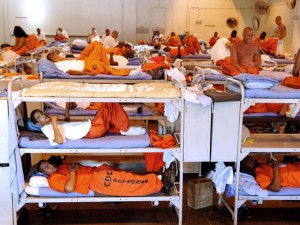Supreme Court Orders California to Reduce its Prison Population
The U.S. Supreme Court recently ruled that California’s prisons are so crowded it amounts to cruel and unusual punishment in violation of the Constitution. This may well prove to be a landmark ruling, and it further deepened the divide between the Court’s liberal and conservative wings.
The Supreme Court upheld a ruling by a lower federal court, requiring California to reduce its prison population by 23%, or about 33,000 inmates, by the year 2013. Presumably, the deadline was meant to give the state time to come up with a plan to determine how to comply with this order in the most expedient way possible, and how to do it in a way that poses minimal danger to the public safety.
 With this in mind, California officials have unveiled a plan that involves transferring prisoners who committed relatively minor crimes (of a non-violent, non-sexual nature) to county jails.
With this in mind, California officials have unveiled a plan that involves transferring prisoners who committed relatively minor crimes (of a non-violent, non-sexual nature) to county jails.
As you might imagine, county sheriffs in California, who will be responsible for taking on all these thousands of extra prisoners, are not thrilled about the plan. Many county jails in California are suffering from the same overcrowding problems as the state prison system.
If the plan is simply to technically comply with the Supreme Court’s order by moving prisoners out of the state prison system, but keeping them confined in another correctional system (the county jails) which is suffering from many of the same problems, this is hardly a viable, long-term solution.
To really comply with the letter and spirit of the Supreme Court’s ruling, California (and other states) should seriously consider a deeper structural change – reconsidering the usefulness of incarceration as a punishment for some crimes, and if “punishment,” in and of itself, should be the main goal of the criminal justice system.
First of all, to solve the long-term problem of prison overcrowding, states (and the federal government) are going to have to make some difficult decisions: do we spend money that we don’t have to build more prisons, knowing that this strategy would have to continue indefinitely, or do we reduce the number of crimes that are punishable by incarceration, committing the cardinal political sin of being “soft on crime”?
It really seems like the only realistic long-term solution to this problem is a fundamental rethinking of our approach to crime and punishment. Or, at the very least, rethinking how we treat nonviolent offenders should be a major priority.
The U.S. has the highest incarceration rate in the world. And it has grown exponentially since the 1980s. Not coincidentally, this is when the “war on drugs” began. Currently, over 0.7% of the United States population is in prison. Russia, the country with the second-highest incarceration rate, has 0.5% of its population in prison. China, whose government is widely criticized for its authoritarian policies, only has 0.1% of its population in prison. The United States has only 5% of the world’s population, but has 25% of the world’s prison population. In the U.S., there are currently about 2.3 million people in prison – the largest prison population in the world. China, the country with the second-largest prison population, has about 1.6 million people in prison, despite having a population over 4 times larger than that of the U.S.
With most federal and state politicians favoring a slash-and-burn approach to cutting the deficit, it seems unlikely that prisons are going to get a major, costly expansion to adequately house inmates in conditions that pass constitutional muster.
With that in mind, it may be time to take the far more effective, but less politically convenient, path of refocusing our entire criminal justice system on rehabilitation, rather than retribution. One simple step in this direction, which would have the greatest impact on the prison population, would be to reduce, or altogether eliminate, prison sentences for non-violent, low-level drug offenders. In addition to saving the government a huge amount of money, this would free up a significant amount of space in the prison system, greatly reducing crowding, and improving conditions. For serious addicts, mandatory drug treatment would be an option, and might prove less expensive (both in financial and societal costs) than prison, in the long term.
For dangerous criminals who need to be incarcerated for the safety of everyone else, the focus should be on rehabilitating them into productive members of society, rather than simply locking them away and forgetting they exist. Of course, there will always be people out there who have no desire or ability to be rehabilitated, and will always be a threat to others. Those individuals should be locked away, for life, if necessary.
If this sounds like a proposal to “coddle” criminals, I ask you this: as a taxpayer, would you rather pay for a criminal to live in a prison for the rest of his life, getting a clean bed, cable TV, and 3 square meals a day, or would you rather spend a little more money and effort upfront, to help that same person become a productive, contributing, taxpaying member of society? I certainly know what my preference would be.
Taking a long, hard look at our prison system is a generation overdue. Rather than rearranging the deck chairs, and passing the buck on to our children, maybe we, and our leaders, should actually try and do something now.


Comments